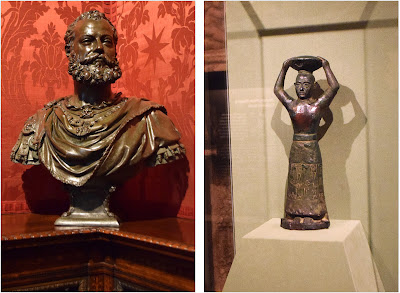 |
| Portrait of J. Pierpont Morgan, 1888, oil on canvas, by Frank Hall (1845-1888) |
Part One: The Library
 |
| (Above & below) The recessed portico is flanked by a pair of stone lionesses |
 |
| (Above & below) The East Room |
 |
| (Above & below) Allegorical depictions of the arts and sciences alternate with portraits of figures identifying the library as a place for the preservation of art and ideas |
 |
| Beginning directly above the fireplace and moving to the right, these figures are Dante Alighieri, Comedy, Sandro Botticelli, Painting, Michelangelo Buonarotti, Architecture, Antonio da Sangallo, Poetry, Socrates, History, William Caxton, Music, Herodotus, Science, Galileo Galilei, Astronomy, Christopher Columbus, and Tragedy  |
 |
| The Gutenberg Bible, 1455 |
 |
| (L) Jeweled cover of the Lindau Gospels, France, workshop of Charles the Bald, ca. 870-80. (R) Enameled Book Cover with Crucifixion Plaque, copper-gilt and champlevé enamel, Lomoges, France, 1190-1215 |
 |
| (L) Bronze bust of Alfonso II d’Avalos (1502-1546), Marquis of Pescara and Vasto, by Annibale Fontana (1540-1587). (R) Foundation Figure of King Ur Namma, Sumerian, Mesopotamia, Third Dynasty of Ur (ca. 2112-2095 B.c.); copper Inscribed: Ur-Namma, king of Ur, king of Sumer and Akkad, the one who built the temple of Enlil |
 |
| Gospel Lectionary, in Latin, Germany, Magdeburg, ca. 1220-30 |
 |
| Stavelot Triptych, Belgium, Abbey of Stavelot (southeast of Liège), setting and madallions, ca. 1156-58, Byzantine enamels from Constantinople, ca. 1100 |
Also see:
• Back Among the Ruins and the Forest Passage (Part 2)
• Among the Ruins and the Forest Passage
• Briganti Field Trip: Maker of Middle-Earth Exhibit at the Morgan Library & Museum



















